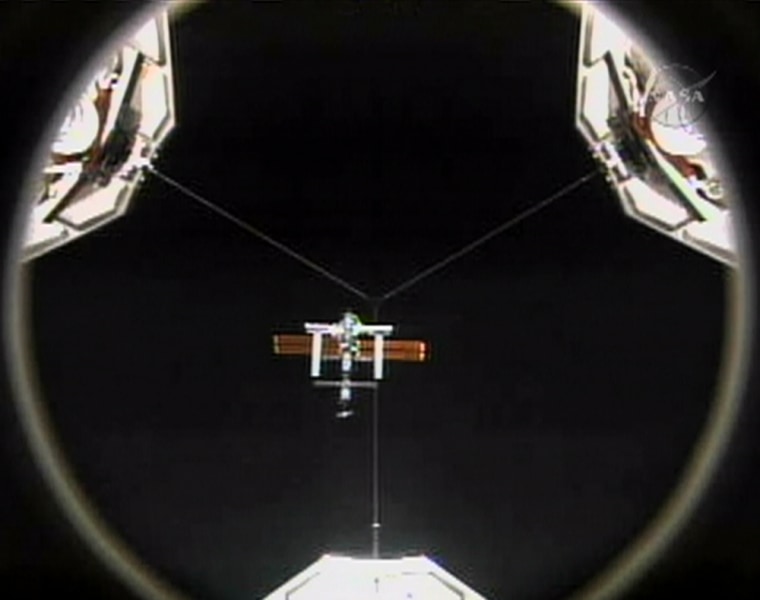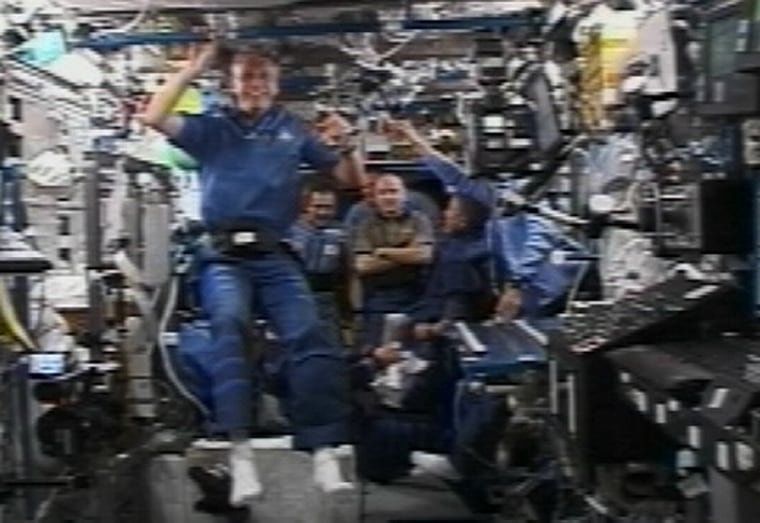The space shuttle Discovery executed a 360-degree flip for the international space station on Thursday, then linked up with the orbital outpost for a visit lasting more than a week.
After checking for leaks and equalizing the air pressure, the crews on the shuttle and the station opened the hatches between the two vessels — and Discovery's crew floated into the station's Destiny laboratory for a round of handshakes and hugs.
Discovery is due to spend up to nine days at the station — to deliver more than 2 tons of supplies, test shuttle inspection techniques, and fix equipment that will be essential for resuming space station construction later this year. Astronauts Piers Sellers and Mike Fossum plan to carry out two spacewalks, and most likely a third, which would extend the 12-day mission by a day.
Thursday's shuttle backflip — a maneuver that was first performed during last year's flight of Discovery — was part of the inspection process developed after the 2003 Columbia tragedy. From a distance of about 600 feet (185 meters), the station's crew snapped high-resolution pictures of the shuttle's protective tiles and reinforced panels. All that imagery was then downlinked to NASA experts and analyzed for any signs of damage to the shuttle's underbelly.
After the backflip, Discovery commander Steve Lindsey moved in for the docking, about 220 miles (350 kilometers) above Earth's surface.
Lead flight director Tony Ceccacci said Discovery's maneuvering system worked just as planned, even though one of the heaters for a fine-tuning thruster was on the blink. The crew positioned Discovery so that the thruster was warmed up by sunlight instead of the thruster.
"The plan worked exactly how we expected it to," Ceccacci said.
Ceccacci told reporters that he was "very happy about how things are going," but he declined to say that shuttle operations were finally back to normal, more than three years after Columbia and its crew were lost. "Nothing will ever be normal when you're going up to space," he said.
So far, no serious damage noted
One big focus of Discovery's mission is to test safety modifications made since the Columbia tragedy — and since last year's flight of Discovery.
Columbia's seven astronauts were killed during re-entry in 2003 because foam insulation debris from the shuttle's external tank damaged the leading edge of the orbiter's left wing. The tank was redesigned, but potentially hazardous foam flew off again during last year's flight, forcing another round of modifications.

So far, the inspections on this mission have not turned up evidence of any significant damage to shuttle tiles, said John Shannon, chairman of Discovery's mission management team.
"We were looking for things to talk about at one point," Shannon told reporters Thursday after the team's review. He said the lack of tile damage was "a surprise, but a pleasant surprise."
On Wednesday, Discovery's crew conducted a detailed survey using cameras attached to a 50-foot (15-meter) boom, and spotted a thermal tile filler poking about a half-inch (1 centimeter) out of the shuttle's belly.
Shannon said two protruding gap fillers were spotted in Thursday's imagery, plus bits of what appeared to be fabric on the shuttle's underbelly and around the nosecap.
During last year's flight, two fabric gap fillers had to be removed in orbit, but Shannon said it was too early to tell whether a spacewalk would be required this time. NASA planned another round of focused inspections on Friday to get more data and fill in gaps in the imagery, he said.
Earlier imagery showed two areas where foam insulation was lost around areas of the tank known as ice/frost ramps. Shannon said one area of foam loss was about 12 by 14 inches (30 by 35 centimeters) and a half-inch to an inch (1 to 2 centimeters) thick. But the foam debris was too small and came off too late to pose a threat to the orbiter, he said.
Last month, NASA's safety director and chief engineer recommended against launch until the area around those ice/frost ramps was fixed. Engineers are still working on a redesign for that area of the tank, and NASA shuttle program manager Wayne Hale said the first tank with modified ramps should be ready for flight early next year.
German astronaut joins station crew
One of Thursday's key events was the official transfer of European Space Agency astronaut Thomas Reiter from Discovery's crew to the space station's Expedition 13 crew.
Discovery's astronauts were awakened on Thursday with a recording of Elton John's "Daniel" — the choice of Reiter's wife and two sons.
Reiter, who has a son named Daniel, will spend six months living on the space station, bringing the size of the crew to three people for the first time in three years. The German native will be the station's first long-time resident who is not an American or a Russian.
"With a third long-duration crew member coming from Europe, in this case from Germany, other colleagues from the European Space Agency will follow," Reiter told NBC News in a pre-launch interview. "It adds, maybe, a little bit of internationality to the station."
The crew size was reduced in the years after the Columbia tragedy, when NASA's shuttle fleet was grounded. Russian vehicles weren't large enough to keep the space station supplied for more than two people.
This report includes information from The Associated Press.
